Ethical email marketing
Automation is here, AI is here, we have more tools than ever to send truly personalised email marketing. We can analyse and get to know our customers better than ever....and it’s getting a bit creepy.
In this blog, let’s take a step back and look at how personalisation should make the marketing experience better for the customer, and the ways in which it can go wrong. Let's review how we can create ethical email marketing campaigns, and what they need to look like.
Done right, in the long run, ethical email marketing builds our reputation, gains us the trust of our customers, and ultimately boosts our revenue. But there are many ways in which it can go wrong…
Right or Wrong?

Campaigns like this one from Burger King are Marmitey - you either like it or you loathe it. Would a moldy burger make you want to buy? But, then again, would you want to buy a burger that remains strangely pristine after 28 days?
This campaign is focused on proving that only natural ingredients are used in Burger King’s burgers (a burger which does not decay clearly has some dubious chemical enhancements).
Ethical marketing is similar. On the face of it, it may seem contrary to the principles of marketing. But look a little closer, and you’ll see that it’s actually sending a very important message.
What is ethical marketing?
Put in the most basic of terms, unethical email marketing is what you find in the Spam folder.
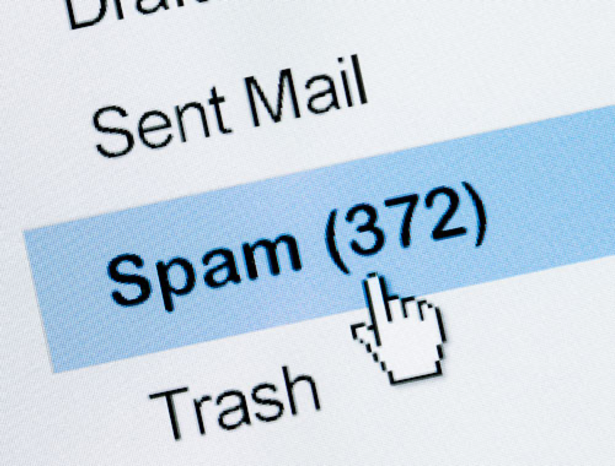
Ethical marketing, on the other hand, is:
- Consistent in tone and content
- Sent only to those who want it (opt-in subscribers)
- Valuable and relevant
- Well timed (i.e. does not disturb the user at inopportune moments)
- Not exploitative
- Truthful (does not make false claims)
- Socially responsible
Behind the scenes, it also uses data and technology in an ethical manner.
Technology & data
Technology and data play a big part in email marketing. They help us do a lot of things. However, like most things, there is a right and a wrong way to use these powerful tools. Take this Jet Blue customer’s brush with facial recognition technology as an example:
Here, we see a new technology forced upon people without their knowledge or consent. Pushing potentially invasive tech like this on the public without giving them a choice (or, indeed, informing them) causes friction. Using any new technology with neither an explanation nor information as to where the data is coming from (or being stored) is always going to raise concerns.
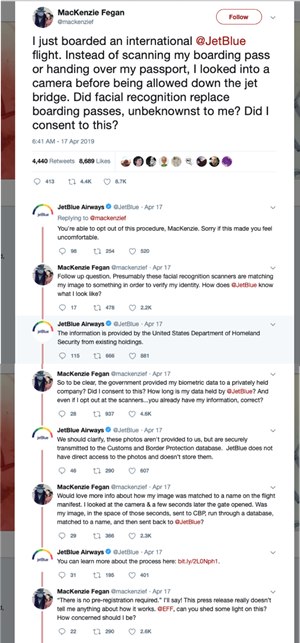
From Jet Blue’s point of view, the technology helps to speed up the process and is ultimately trying to improve the customer’s experience. Facial recognition tech removes the irritating need to hunt around for a paper boarding pass or download an app to your smartphone (and then have to increase the brightness on your phone and zoom the QR code for the scanner to accept it). In theory, it smooths the airport experience. And it would be a great idea…if done ethically.
Not letting consumers opt in to this process removes the vital element of personal autonomy. It raises valid concerns around data, data storage, and very basic personal privacy.
So, consider the concerns your customers may have as you introduce new technology.
Be prepared to inform them at all stages, and toanswer any queries they may have. Show them the benefit of your new approach, and let them maintain control.
Even with the latest technology, the journey isn’t seamless
How many times do you still see this in your inbox? This was a brilliantly customer focused campaign by Taco Bell, rewarding customers on their birthday with free tacos. However, by greeting valued customers as ‘Fname’, all the good intentions are immediately lost.
The dreaded Fname issue is a risk of personalising email campaigns. But it doesn’t have to be. Having a default for any instances where the data isn’t available to display (or when you don’t have confidence in the accuracy of your data) is the best approach. Research repeatedly tells us that consumers like to be treated as a person and not a number. Thus, personalization errors do a lot more harm than good.
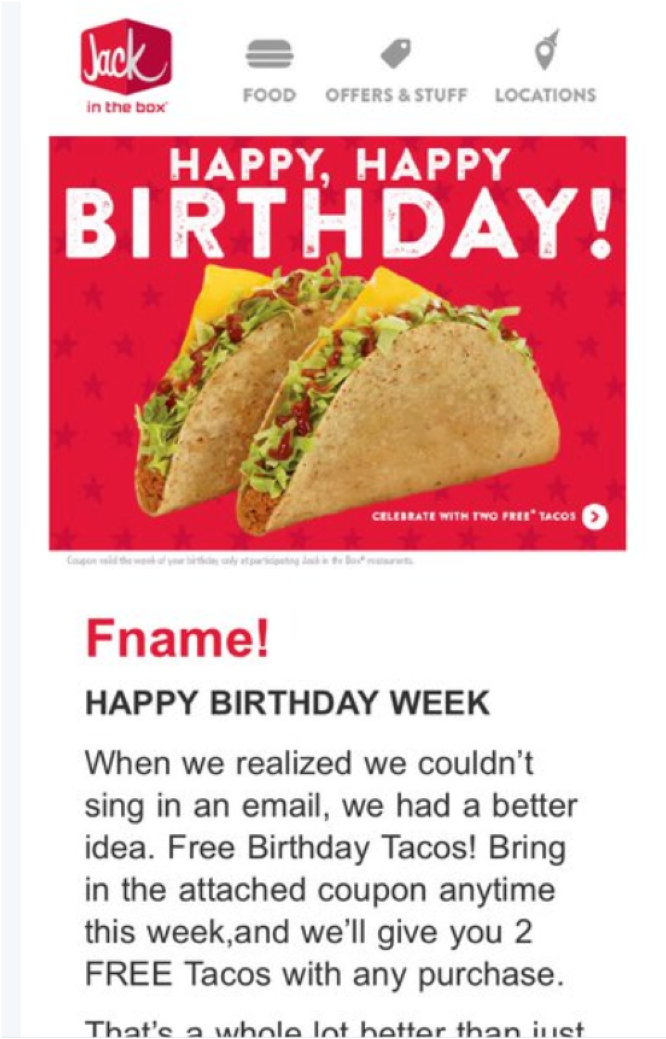 Personalisation is a topic that has been heavily discussed and exhaustively used in the email industry, but that doesn’t mean it’s not open to abuse.
Personalisation is a topic that has been heavily discussed and exhaustively used in the email industry, but that doesn’t mean it’s not open to abuse.
Does this below look familiar in your inbox?
- Subject line: Jenna, was it something I said?
- Subject line: Hi there, Jenna, it’s me again…
- Subject line: This is my third attempt to contact you, Jenna.
- Subject line: Jenna, I just can’t seem to reach you
- Subject line: Jenna, I know you’re busy, but…
- Subject line: Jenna, I get the feeling this isn’t a priority.
- Subject line: Jenna, should I wave the white flag?
So after repeatedly not opening the emails (which are from a sender I do not know, and do not know how they got my name let alone my email address), this is a series of emails I received over the space of a week.
In response to the final email, yes, you should definitely wave the white flag, because no self-respecting prospect is going to fall for this ploy. This isn’t an ethical use of data. This is misuse. If this kind of thing happened in real-life, it would be considered stalking. Why is this kind of behaviour still considered acceptable in the inbox?
Context is crucial
We are all currently facing a tough time, both personally and as marketers. My advice to all email marketers it to pause all automated campaigns.
Yes, really. Take this time to review them, adjust them and - if still appropriate continue - to send them. But don’t let them run on regardless. In the current situation, ‘business as usual/ emails seem shockingly out of context. For example, here is an email I received only a few days ago. It is robotic, and appears utterly tone-deaf for the world as it is today. Celebrating the organisation’s birthday during a time of unprecedented pandemic circumstances is as best bizarre, and at worst insulting. The copy makes it clear that this campaign was created months ago. And as for the ‘A lot has changed in 9 years…’ headline…well, at the moment things are changing by the hour! This campaign is astonishingly out of context.
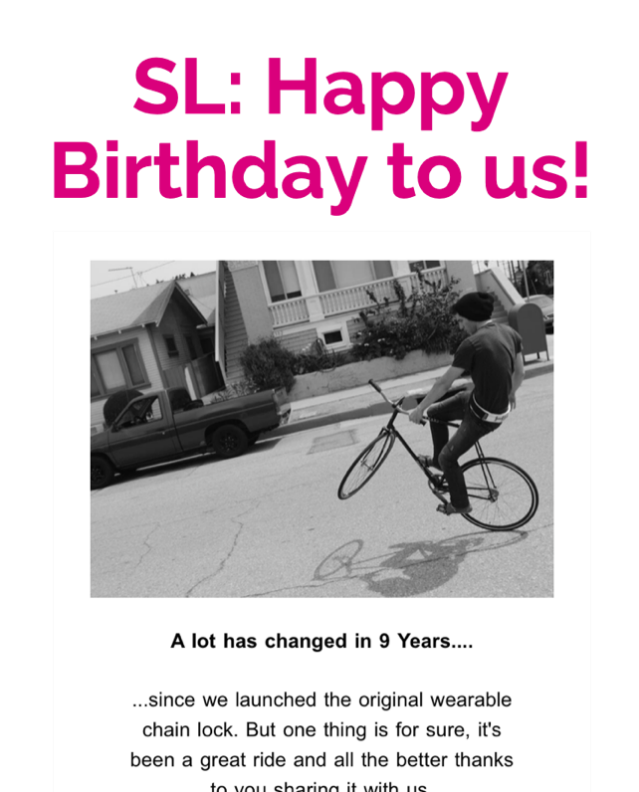
This campaign could have been about celebrating customers birthdays. That would have been better. This inward facing organizational approach needs to end. Now more than ever is the time more to display the human side of your organisation. Automation is an amazing tool. It enables us to plan ahead, focus and spend our time on strategy, testing etc. But never let automation lull you into a ‘set and forget’ mindset.
“Good intent is not enough”
Kait Creamer, LitmusLive, 2019
Your audience may not speak your language. This is an important lesson most marketers learn the hard way.
Empathy in marketing can go a long way towards building relations, loyalty and, ultimately, performance. It’s no good saying that you care about your customers and then constantly bombarding them with discount offers during a time of panic.
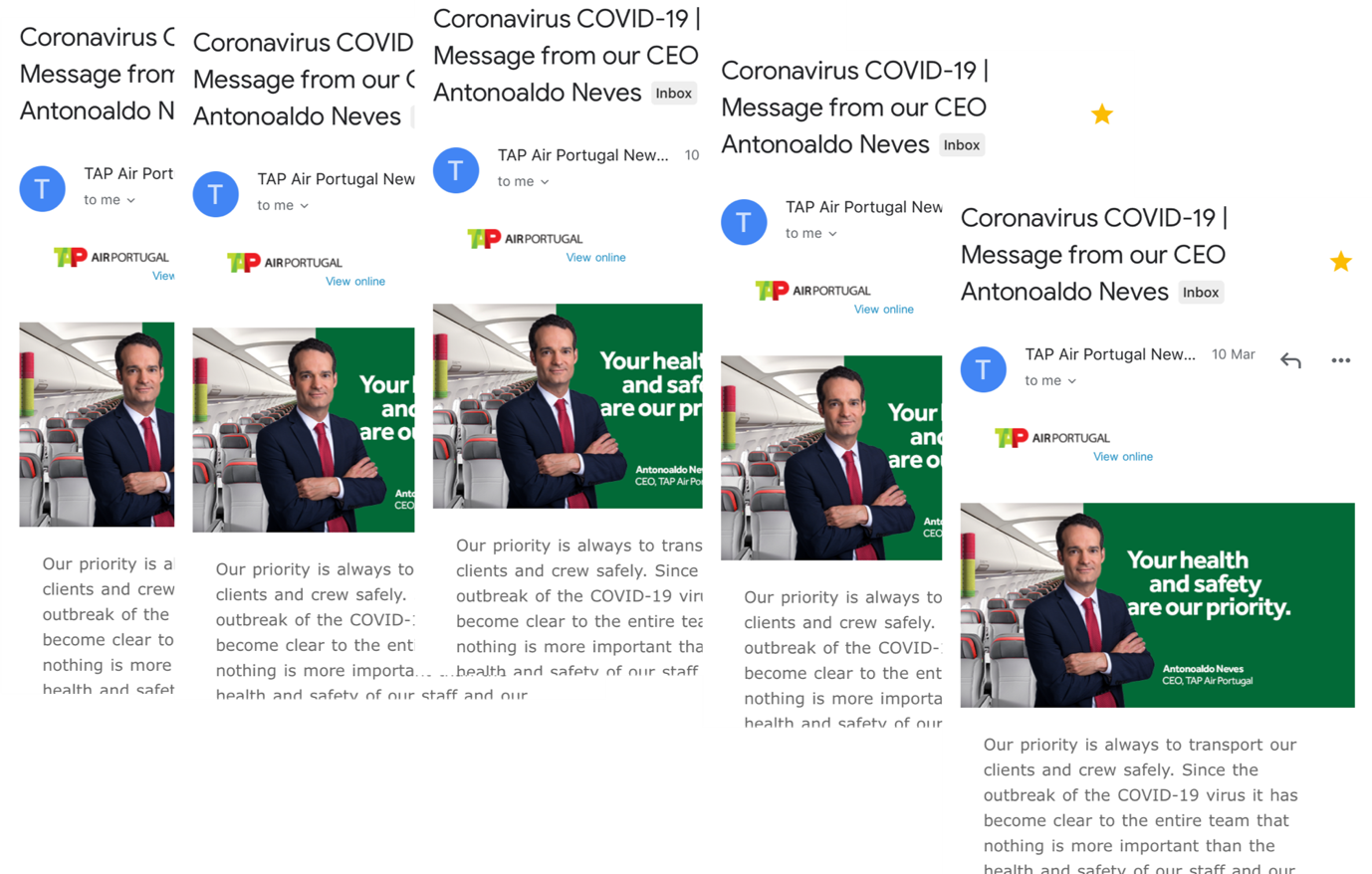
The intentions here are good. It’s nice to send an email campaign to keep your brand front of mind. The thing is, outside the brand bubble, consumers are receiving a similar ‘message from the CEO’ from every airline, bank, network, service provider, and…well…everyone. Before long, the empathy starts to get lost.
Avoid using this time as an opportunity for brand messaging. Always keep the wider human context in mind. Send useful communications to your customers and subscribers. Consider the main queries you’re currently receiving. Can you help answer these queries and reassure customers through email? What are your customers biggest concerns? How can you organisation help?
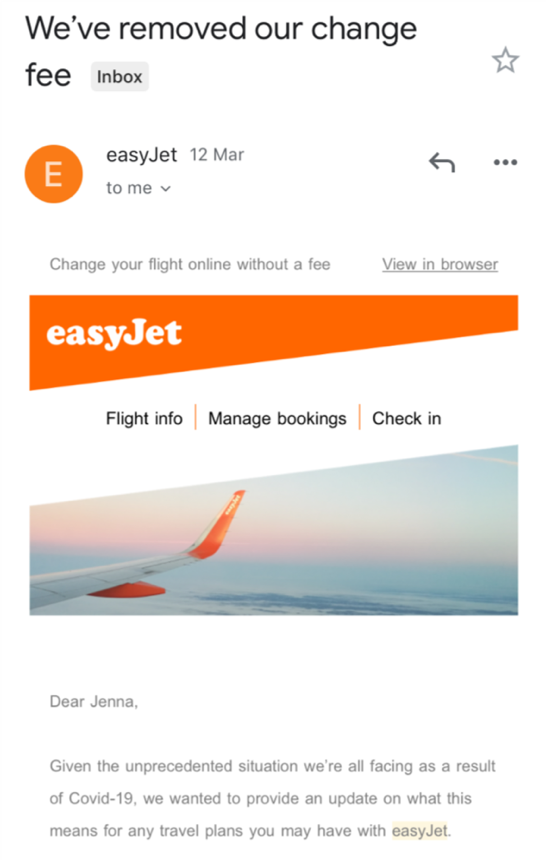
Easyjet have had a brilliant approach to this. They recently sent an email communication notifying all subscribers and customers that have removed their fee to change flight bookings. They have also responded to customer concerns around uncertainty of when to change their booking, and have provided an early release of their 2021 flight to help customers. Of course, there is an element of commercial gain here, but Easyjet are also and obviously trying to reduce any concern or burden their customers are feeling. It’s perfectly pitched for these troubled times.
So what are my top tips?
- Pause all automated campaign(s) & review automation journey(s) being sent- are they relevant to today’s context right now?
- Review your tone. Do your communications sound human or robotic? – Can they be tweaked and adjusted?
- Do your communications share the real-life emotions that they would be greeted with in person? – Consider, if you were talking directly to a customer in store, would you use more empathy, more compassion etc than the email displays?
- Put yourself in the customers situation. How would you receive this email if you were in their position?
- Marketing today should be about being helpful, generating value and being human. Now is not the time to pushing your brand, now is the time to align your organisation with supporting your customers and prospects during this time of need.
We are all facing unprecedented times ahead, but consider the value that your email campaigns can give your subscribers. Brands and organisations that are adapting and supporting consumers are the ones that will be remembered in the future.

 How to resolve AdBlock issue?
How to resolve AdBlock issue? 
 Jenna Tiffany is Founder & Strategy Director at Let'sTalk Strategy providing strategic consultancy services across the digital marketing mix. Jenna is a Chartered Marketer and elected Fellow of the IDM with over ten years’ marketing experience across both B2B and B2C. Jenna has consulted with brands such as Shell, Hilton and World Duty Free to name a few on digital and email marketing strategy.
Jenna Tiffany is Founder & Strategy Director at Let'sTalk Strategy providing strategic consultancy services across the digital marketing mix. Jenna is a Chartered Marketer and elected Fellow of the IDM with over ten years’ marketing experience across both B2B and B2C. Jenna has consulted with brands such as Shell, Hilton and World Duty Free to name a few on digital and email marketing strategy.